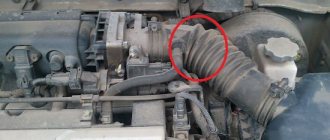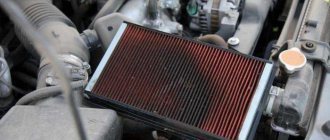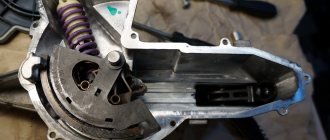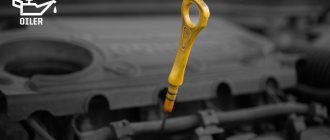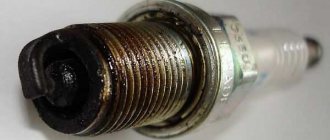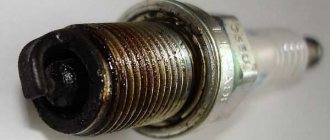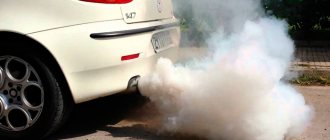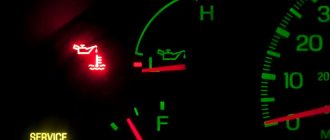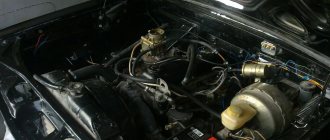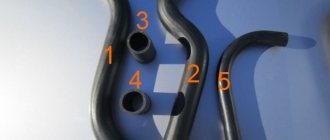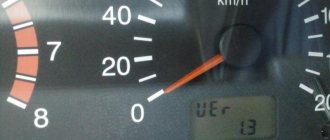The main device that makes a car move on our roads is the internal combustion engine (ICE). In turn, the engine will not be able to function without engine oil - the main consumable material that ensures durable and reliable operation of this power unit. The oil fluid is retained inside the lubrication system by gaskets and seals made of elastic materials. Unfortunately, these parts do not always last long. That’s why you can often hear the following phrase from motorists: “My engine is leaking oil. What could be the reason?"
Signs of Oil Loss
Oil leaks from the engine occur for various reasons. Therefore, signs of loss of lubricant also manifest themselves in different ways.
The most common sign that immediately shows that there is a malfunction in the car is an oil slick in the area of the engine crankcase. It usually appears when the car is parked for a long time. That is why experienced motorists inspect the space under the bottom every morning, between the front wheels of the car. Even if a stain or a small puddle appears, it is not a fact that the engine is leaking. The leak sometimes occurs from the gearbox; there is also gear oil there.
The second main sign is a drop in the oil level, which can be seen on the dipstick. To do this, stop the car on level ground and wait 10–15 minutes for all the lubricant to flow into the engine crankcase. Having removed the dipstick, wipe it well with a rag, then reinsert it into the neck until it stops. If the lubricant level has dropped, you need to immediately find out the reason. It seems that there are no oil stains or smudges, but the lubricant is leaving. The fact is that motor fluid can not only leak, but also burn out while the engine is running. If you place the vehicle on an inspection hole, or drive onto an overpass, a visual inspection will help localize the problem.
What and where can leak from a car and why is it dangerous?
Engine oil
Oil leakage from the engine lubrication system is a fairly common occurrence, which is why in many parking lots the asphalt is literally dotted with characteristic oily spots. Identifying an oil leak is quite simple: a small and thick greasy stain cannot be confused with water or even antifreeze. Under the hood, the problem usually reveals itself either as fresh traces of oil, if the leak is fresh or strong, or, conversely, as growths of dirt covered with oil, if the engine has been losing oil drop by drop for a long time. As a rule, oil leaks from the engine due to leaks in the crankshaft seals and the sump. However, these are only the most common options: you need to inspect the entire engine, and if traces of oil on the crankcase protection are fresh and no leaks are visible, it is better to inspect the car on a lift.
If the puddle is large, then you need to carefully inspect the crankcase - it is possible that it was punctured on the road. In any case, you need to check the oil level and also visually inspect the engine. Driving with a low level on the dipstick is more expensive for yourself, because many engine parts may experience oil starvation.
If the emergency pressure lamp is on or even blinking, you definitely shouldn’t move on: low oil pressure means its critically low level, which can kill the engine within a few kilometers. In such a situation, you need to immediately turn off the car and then transport it using a tow truck. But even if the level is normal, you shouldn’t delay repairs, because due to “hardened” crankshaft seals, oil can get on the drive belts or clutch disc, and this will lead to completely different problems.
1 / 3
2 / 3
3 / 3
Transmission oil
It is not easy to distinguish engine oil from transmission oil, but there are still some features. Transmission oil is usually noticeably thicker and remains light even after a long time after replacement, but motor oil darkens over time. Another way to distinguish the type of oil is to drop it into water: the motor oil will remain there in the form of a lens drop, and the transmission will begin to spread. Well, a careful inspection of the gearbox from below will help you understand where the oil is coming from. An oily body is a reason to immediately check the oil level if a dipstick is provided structurally.
And although in Soviet times some lucky people managed to get to the garage with an almost “dry” gearbox, engaging fourth (direct) gear, modern practice knows many cases when even seemingly unpretentious mechanics fail prematurely due to the fact that the owner several thousand were driven with a low oil level, which the gears really don’t like – especially those located highest in the unit.
For an automatic transmission, the oil level is even more critical, so hitting the road with such a leak is literally a death sentence for the automatic transmission. It is even easier to determine that it is the automatic transmission that is leaking than in the case of a manual transmission, by the characteristic color of the oil, which usually varies from red to burgundy-brown.
1 / 3
2 / 3
3 / 3
Obvious oil leaks from the transfer case, center differential or rear axle gearbox indicate leaking oil seals or damage to the housing. A “dry” gearbox usually quickly begins to hum and howl, and in the worst case scenario it can jam right on the move.
Coolant
In a liquid-cooled engine, antifreeze plays an important role, and the system itself must remain sealed. However, due to high temperatures, its individual elements may lose their tightness, which is especially typical for older cars. We talked in detail about the main causes of antifreeze leakage, and now we will remind you again. Keep your fingers crossed: the culprits may be leaky radiators (main and interior heater), a leaking thermostat (engine or automatic transmission), a burst expansion tank, a malfunctioning expansion tank cap, cracked pipes and hoses, the main or additional water pumps, and even the cylinder block itself!
1 / 3
2 / 3
3 / 3
Experienced drivers can recognize antifreeze by tasting a suspicious stain, since ethylene glycol, which is the basis of almost any antifreeze, has a sweetish taste. However, we will not advise you to engage in such organoleptics: even though ethylene glycol is a moderately toxic substance, and for poisoning you need to take a couple of sips, but in each specific case it is unknown what other impurities may be present in the stain on the asphalt. It is better to try the liquid by touch: the antifreeze is slightly oily. So if the stain is not purely oil, but also has a color (greenish, reddish, yellowish, and so on - there are many options for dyes) and is greasy to the touch, it is most likely antifreeze.
If the antifreeze leak is severe, then you can get to your home or repair site by simply adding water to the system. However, this is quite a risky business, since you will need to constantly monitor the level of antifreeze and the temperature of the coolant in the system. If the coolant level drops below the minimum while the engine is running, the engine may overheat. The likelihood of the engine “boiling” is especially high in the heat and in traffic jams, so if the leak is severe, and it’s summer and there are still several kilometers ahead, it is better to immediately call a tow truck.
Brake fluid
The most dangerous leak is loss of brake fluid. If it is already on the asphalt, this usually means that the car literally has no brakes, because the volume of the braking system, unlike lubrication or cooling systems, is very small - no more than a liter. As a rule, even a small leak of brake fluid leads to the failure of one of the circuits or the complete failure of the brake system, because it immediately becomes airy. The bad thing is that it is not always easy to notice the location of the leak - for example, the rear brake cylinders are located inside the drums, and on the outside they are covered with shields. A sure and bad sign of a brake fluid leak is traces of fluid on the inner surface of the wheel.
1 / 3
2 / 3
3 / 3
A cracked brake hose or broken brake pipe will have the same effect - the brakes will simply stop working. In Soviet times, in order to get to the garage, failed brakes on individual wheels were turned off in any suitable way, and any liquid was poured into the hydraulic drive, including water, castor oil or alcohol. However, we categorically do not recommend any of these “folk methods”. Firstly, it is deadly: a drop in pressure in the system means it is impossible to brake. And secondly, traffic regulations prohibit continuing to drive with a faulty brake system, and any leakage of the brake fluid is a clear sign of a malfunction.
Fuel
You can tell that fuel is leaking from a car by its sharp and characteristic smell - both in the case of gasoline and diesel. There may be several reasons: a rusted or damaged tank by a foreign object, a defective metal fuel line, a burst fuel hose, a cracked filter housing, or damage to the filler hose at the filler neck. The result is always the same: fuel flows onto the street or, even worse, onto the engine.
Loss of tightness in the fuel system can also occur after unqualified repairs - for example, when changing the fuel filter, out of ignorance, the cheap o-rings on the fuel lines were simply not replaced. It is unnecessary to talk about the high fire hazard of gasoline, so any such leak is a reason to sound the alarm and not only not to continue driving, but not even to leave the car unattended, because someone might decide to smoke nearby. We will not recommend the “old-fashioned” method of eliminating gas tank leaks using soap: this was acceptable 40-50 years ago, but now the verdict is clear - only a tow truck.
Power steering
A leaking rack usually leaves marks on neighboring components - the subframe, suspension parts, and so on, but reddish fluid from the power steering gets onto the asphalt only if the system, as they say, has “died.” Leakage can occur not only from the rack itself, but also from hoses and lines, both at the joints and through cracks in the hoses themselves. Therefore, if there are oil leaks under the car and the level in the engine compartment of the power steering reservoir drops, you need to inspect all lines for breaks and major damage. Typically, power steering uses the same red oil as automatic transmissions: this is worth keeping in mind to identify the source of the leak.
It is theoretically possible to drive further with a strong leak and an empty engine compartment tank: even in the complete absence of oil, the rack retains the ability to turn the wheels. But from the point of view of the law, this cannot be done: traffic regulations prohibit the operation of a car if the power steering is faulty. Therefore, moving without oil in the system should only be done as a last resort and over short distances, and safety precautions must be observed. After all, a non-working amplifier means that it will take much more effort to turn the steering wheel - even more than on cars without an amplifier. In addition, driving with a lack of oil in the system can provoke further breakdowns: the pump may jam or its drive belt may break, to which, depending on the design features, other units may be tied. If you notice a leak from this system, you need to do the same as in the case of the engine and gearbox - check the level and add fluid.
Air conditioner
Having discovered that something is dripping from a car with a running engine, many drivers panic. In the case of an air conditioner, fears are completely unfounded: if the system is turned on, then condensation is simply obliged to flow out. For complete peace of mind, you can make sure that it is water that is dripping onto the ground by testing the liquid to the touch.
But no oiliness should appear in the condensate or on the tubes - this may indicate that the system will soon fail. Moreover, the fact that the air conditioner will stop cooling the interior is not the biggest problem, because if the compressor jams, the drive belt may break, and we have already found out what this entails in the previous section.
Other options
There are several other sources in the car that can leave traces of a leak. The most non-trivial option is a leaking shock absorber, although usually this failed suspension unit only “sweats” and does not leak so much that it drips all the way to the ground. Much more often it leaks from the washer reservoir, its nozzles or connections on the pipes - these drips are generally harmless, but also indicate that not everything is in order.
The only exception is leaking headlight washers if they have just been running. In cars equipped with a hydraulic headlight leveler, fluid leaks from the hydraulic drive are possible, but often the actuator cylinders “leak” directly into the headlight. Well, we will end with water from the exhaust pipe - this is a normal phenomenon, since it is ordinary condensation.
Causes of leaks
In order to fix the problem, you need to find out why the oil is leaking. The reasons may be different:
- Defective gaskets or seals. There are a lot of them in the engine - in the area of the gas distribution mechanism (GRM), cylinder head (cylinder head), oil filter, crankshaft, as well as other components of the power plant.
- Malfunction of the crankcase ventilation system. While the engine is running, some of the exhaust gases break through the oil scraper and compression rings into the crankcase. They create excess pressure on the engine oil. Thus, the lubricant can be squeezed out through the seals or gaskets, because some of them may not withstand such pressure.
- Poor quality oil fluid. Counterfeit motor fluid is often sold on the market under the guise of original fluid. It is quite difficult to recognize it, so car enthusiasts, especially inexperienced ones, often buy fakes. The operation of the engine leads to an increase in temperature to 250–300°C in the area of the cylinder-piston group. The counterfeit product loses its viscosity and liquefies. In this state, it leaks through the seals in large quantities. The same applies to waste - flowing through the piston rings, such “oil” burns along with the fuel. Fumes are indicated by the bluish color of the exhaust gases escaping from the exhaust pipe.
- Finally, the most common reason is damage to the oil pan during a trip. Sometimes objects come across under the bottom that can seriously damage the pallet. That's why some automakers, as well as many car owners, install additional protection on the crankcase.
Let's take a closer look at which components most often leak engine oil.
Preparing to find a possible oil leak
Firstly and initially, before you start looking for an oil leak, you must clean the surface of the engine itself from dirt and dust. This will make it easier for you to locate the greasy stains left by motor oil or other vehicle fluids.
To clean the engine from dust and dirt, you can buy a special cleaner at a car store and wash the power unit of the car yourself. You can also pressure wash your car engine at a car wash.
This is interesting: Extended car warranty: An expensive gamble
Please note that cleaning the engine using a special cleaning spray manually or in a car wash should only be done with a cold engine. In the process of washing the engine, you must also clean not only the power unit itself, but also all hoses, brackets, the engine pan, and at the same time wash the bottom of the car and its suspension.
Attention! When cleaning the engine, you should be sure to protect all electrical connectors and exposed terminals on the machine with sealant material. Otherwise, you simply risk accelerating the corrosion of the car’s electrical components or simply not starting the engine after such a wash.
Crankshaft oil seals
If an oil puddle has formed under the car, you need to find out where the engine oil may be leaking from. One of the most likely paths is crankshaft oil seals that are damaged due to the use of low-quality engine oil or have exhausted their service life. The wear-resistant rubber from which they are made is also subject to aging - due to high temperatures, as well as aggressive external influences. Overheating of the motor, contamination, frequent use of flushing, poor lubrication - all this gradually destroys the material of the seals.
To replace them, you will have to do some serious work - disconnect the gearbox, rear-wheel drive driveshaft (if equipped), starter, clutch and other components. After replacement, all this will need to be installed back. Often, the crankshaft bearings are replaced along with the oil seals - so as not to disassemble the whole thing twice.
Oil is dripping from under the drain plug: reasons - what to do?
Leaking from the drain plug is a common problem, especially after the next oil change. The machine often heats up during operation, so if the oil is chosen incorrectly, its components may crystallize and a small amount of sediment will form, which will cause the plug to stick to the thread. To unscrew it, you need to break the thread or damage the plug. Therefore, in car repair shops, after changing the oil and screwing in the plug, leakage is often observed.
Oil is dripping from under the drain plug, reasons for what to do:
- Replacing the plug. Often the thread is broken on the pallet itself, in which case it is necessary to replace it. You can also replace the plug and cut a new thread. A new plug can be ordered from a turner, since its sizes are standard in car dealerships.
- The method for the lazy is to use a sealant, sealant . Sometimes tanganite is used for these purposes. This is a thread used to seal water and gas pipes. According to the technical specifications, it can withstand temperatures up to 130 degrees and quite high pressure, so it is quite suitable for these purposes. However, experienced motorists argue that this is not the best solution to the problem, since the thread can melt and lead to more serious consequences - replacing the pan.
Traces of oil
Filter gasket
When the engine lubricant is changed, the oil filter is also replaced. Before installing it in place, be sure to lubricate the rubber gasket with oil. This helps to screw the cleaning device more tightly to the engine body. If this is not done, which is sometimes carelessly forgotten, the gasket will be deformed when screwed in, which can lead to engine fluid leakage. Fixing this problem is quite simple. In most cases, it is enough to tighten the filter harder.
Repairing oil leaks in a car
Once you have found the source of the oil leak in your car, it is time to decide for yourself whether you can fix it yourself as soon as possible. For example, even if you do not have sufficient experience in servicing and repairing a car(s), you can still quite easily fix a leak that has formed, say, from the same valve cover gasket.
In certain cases, you can also fix oil leaks from the oil filter yourself. In other cases, you will need some experience in car repair and maintenance, as well as a repair manual for your specific car model. Especially if this oil begins to leak due to wear of the crankshaft seals. If you do not have and do not have such experience, then if such an oil leak is detected, you need to contact a technical auto center as soon as possible. True, for our part, we still advise drivers to establish the location of such a leak on their own in order to avoid certain deception in the future at a car service center.
Fortunately and as a rule, oil and other fluid leaks are rare in new or fresh cars. But as the mileage of the car increases and depending on the load on the car during its operation, many gaskets, seals and oil seals on the car begin to wear out, which can just lead to leakage of any of the liquids in it. Gaskets and seals in the engine can wear out especially quickly due to sudden temperature changes.
Therefore, friends, from time to time you should not only change the oil, oil and air filter, but also conduct a thorough inspection of all the main components of the car. This is the only way you can detect in time a possible leak of oil or other fluids in the car.
Don't be afraid of your car and be bold. Each of you motorists is able to inspect your car from time to time for any leakage of any liquid. You don’t need any special skills or specific skills for this. Your main task is to detect the leak in time.
Always remember that periodic inspection of the car, engine compartment and at the same time timely scheduled maintenance will help you keep your car in good and decent condition, and will also protect you from major breakdowns. All this will allow you to save not only your nerves and time in the future, but also naturally save your own money. Good luck to all friends!
Oil seals
These parts have another name - valve seals. The valves, which are part of the gas distribution mechanism, are located in the upper part of the cylinder head. To prevent oil from the intake and exhaust valves from entering the combustion chambers, valve stem seals are used. They are made from special rubber, but over time it loses its qualities. If at least one oil seal begins to leak, the lubricant enters the chambers, where it burns along with the fuel. Since the oil does not burn completely, various types of deposits form in the engine, accelerating its wear. Even if the lubricant mixture is of very high quality, it may not cope with so much carbon deposits. This phenomenon is often observed in engines with high mileage. How to fix an oil leak? Only by disassembling the cylinder head block and replacing all caps with new ones.
Diagnostics at a service station - what to pay special attention to?
It also happens that after many months of struggling with leaks, the car owner goes to a service station. Here he is presented with an unrealistic bill for replacing some oil seal, he drives home happy, and the next morning he notices familiar stains on the garage floor that have not gone away. It is best to carry out an inspection at the station together with the master, so as not to miss anything important. It is also worth giving certain conditions to the specialist:
- fully describe where the liquid is leaking from, what it looks like, how much it is leaking - give all the information that you have in your arsenal regarding the problem;
- then ask to carefully examine all the details that we talked about above, while many craftsmen may persuade you, even without inspection, to simply change any part;
- order diagnostics of the unit from which the liquid is leaking, this will help to understand the reasons for this unpleasant effect, as well as eliminate the consequences of the leak in general;
- order a full service of this unit so that the technician can add oil if necessary or change it altogether, and also check the levels of all technical fluids in your car;
- In addition to the above solutions, it is also worth checking the integrity of all boots, which will help prevent the leakage of lubricant mixed with water (very similar to oil).
With such a set of interesting features, you can easily get to the point and fix the problem. Most likely, during the diagnostic process, a unit will be found that needs to be properly serviced. You can get maximum confidence with all the mentioned processes without any problems. But for this you need to choose a professional station. Do not trust the inspection and repair of your car to unverified specialists - this can have a very bad effect on the serviceability of the vehicle. The problem may also lie in banal things, such as in the following video:
Piston rings
This is one of the most common causes of grease waste. If the piston rings are worn out or skewed due to the use of a poor-quality oil composition, the latter enters the combustion chambers.
The situation is very similar to a malfunction of the oil deflectors in the valves. Only here the lubricant leaks through a different route. The consequences are the same - blue smoke from the chimney, large excess consumption of lubricant, loss of engine power. In this case, sometimes flushing the engine helps - it decarbonizes the rings. If there is wear and tear, only engine overhaul will help, there are no other ways.
How can you tell what type of oil is dripping from under your car?
The worst situation is if grease drips through the crankshaft or camshaft seal. In fact, these parts are quite inexpensive, but to replace them you will have to go through most of the car. If you carry out repair work not yourself, but at a car service center, it will cost a pretty penny. If oil is oozing from almost all holes, then with 99% probability we can say that the situation requires serious intervention. These are clogged crankcases, or worn pistons and cylinders. In this case, you will have to completely disassemble the components and replace the motor.
The car engine system is created in such a way that its components are connected using a large number of seals and gaskets. Therefore, if one of them fails, you can observe oil leakage.
How to tell what kind of oil is dripping from under the car:
- At the initial stage, it is advisable to find out which node is faulty. To do this, you need to determine what kind of lubricant is flowing. They differ in their composition, so the origin of the liquid can be determined using a simple experiment.
- Find the leak and place a large napkin or cloth. It is necessary that a few drops fall on the fabric. Now you need to put the napkin in plain water. If it is motor oil, then the liquid that was on the fabric will sink to the bottom in the form of a large, large drop. If it is transmission fluid, it will rise to the surface in the form of greasy, oily drops. Thus, you can decide whether the transmission system or engine parts need repair.
Traces of oil
Consequences of oil leakage
If a problem has occurred with a leak of the lubricant mixture, it is absolutely impossible to delay repairs. The results can be devastating to the engine. For example, if you take damage to the BGC gasket, several unpleasant consequences occur at once, in addition to loss of oil. If liquid from the cooling system gets into the engine crankcase, everything can end with water hammer and jamming of the engine. Here you can’t get by with a major overhaul - you’ll have to completely change the engine. The same thing can happen if you damage the crankcase - engine fluid leaks out, but you drive without noticing it. As a result, the power plant will also fail.
Conclusion - monitor the oil level with a dipstick and check for leaks regularly. If the oil sensor on the dashboard is working, it should notify you of a problem in time. If not, you need to replace it with a new one.
Why is oil dripping from under the car?
The most common cause is wear on the engine or pistons. During operation of the car, exhaust gases, bypassing the pipe, enter the crankcase, bypassing the piston rings. Accordingly, when the engine wears out, these gases create excessive pressure, as a result of which the oil is subjected to strong pressure and squeezed out of the container.
Why is oil dripping from under the car:
- Failure in the oil sensor area. This is a small device that shows how much oil is left in the container. To connect the measuring device to the system, several gaskets must be inserted. Failure of the gasket causes leaks and oil dripping.
- Oil filter . This usually occurs due to the filter weakening and space appearing between the bolts and the mesh. It is necessary to tighten the bolts further, sealing the filter, or replace it.
- Leaking seals. The main task of the oil seal is to seal, but it does not always cope with this task and often bursts or tears. It is for this reason that a small amount of liquid may leak out. The cost of the seals is low, however, you may need money for the work, since it is difficult to replace simple parts.
- Engine sump gasket leaking. It is necessary to replace the gaskets, or apply a sealant that is used in cars.
Flow
Reasons for decreased pressure
If the warning light on the dashboard comes on, it means the oil pressure in the engine has lost. It is worth remembering that if the engine is not warmed up, it may not light up. If the indicator flashes at low speeds and goes out at high speeds, you need to stop using the car and start looking for the cause of the problem.
- First of all, check the top and bottom of the engine for leaks, make sure that there is enough oil fluid in the power unit. If the volume of lubricant is below normal, the oil pressure will drop and oil starvation will begin. It should be noted that if there are no leaks, but the engine was running at high speed for a long time before the indicator flashed, it means that the lubricant is being wasted.
- Check the condition of the vehicle oil. Do not use too thin or thick lubricant that is not suitable for your car. Most often, it is the use of too liquid a petroleum product that causes low oil pressure.
- If coolant penetrates into the lubricant complex, the pressure will drop. This is due to the following. When the lubricant is diluted with antifreeze, it foams. The oil pump captures the foam. As a result, the volume of motor oil in the power unit becomes lower. Antifreeze can enter the engine crankcase through a crack or through a damaged cylinder block gasket. The problem can be identified by thick white exhaust, emulsion on the lubricant filler plug or on the dipstick.
- The properties of the motor oil are significantly affected by the fuel in the crankcase. If there are any problems with the engine (flammable fuel, low pressure in the cylinder block), then gasoline/diesel enters the combustion chamber, but does not burn out. In this case, the fuel penetrates through the leaky piston rings into the crankcase and dilutes the oil. The viscosity of the lubricant will become lower and lower. If there is no burnout in the cylinder block, the engine runs rough, malfunctions, smokes, and wastes a lot of fuel.
- Why does the oil pressure in the engine still drop? The reason may be a fake or defective oil filter. If it does not have a special valve/washer, then after turning off the engine, the oil from the oil channels and filter element will end up in the crankcase. Each time the engine is turned on, the indicator will flash. Significant contamination of the oil filter can lead to the same effect. Replace the filter on time.
- Low oil pressure in the engine may be caused by a lubricant leak from under the indicator. It will flash when the motor is running.
- One should not exclude the possibility of problems with the lubricant complex. Malfunctions of the oil pump often lead to changes in normal compression. Although manufacturers provide a performance margin, at a certain point the gaps between the pump gears and the housing become too large.
- Problems with gasoline/diesel internal combustion engines are also considered to be the cause of low compression. Because of them, the oil cannot properly press on the parts when supplied. A worn crankshaft/camshaft and piston rings lead to a decrease in compression.
We recommend: The check engine light comes on: 7 troubles - one indicator
Main causes and ways to eliminate them
There can be many reasons that cause oil leakage, there can be several main ones, let’s look at them:
| Malfunction | Remedy |
| During installation, they forgot to lubricate the rubber of the oil filter barrier and it became skewed or deformed during tightening | Remove the barrier, lubricate the rubber and reinstall |
| After replacement, the oil filter was not tightened | Tighten until it stops, but only with your hands without using tools. |
| Leaking due to the oil filter being overtightened during replacement | Remove the barrier; if the elastic band is deformed, replace it and install a new one without using excessive force |
| Damage to the sealing surface of the barrier (the ebb surface on the motor in contact with the rubber band) | Replace barrier |
| High lubricant pressure in the engine | There are many reasons, the oil or barrier may need to be changed |
| Unheated car. On old-style models, oil pumps are installed in which there is no oil pressure relief valve, in case of excessive increase, and the external auto-valve is either not installed or is faulty | Warm up the car, inspect the pump and valves |
| Dirty filter element | Replace the barrier. When changing the filter, tighten it only by hand. Just tighten it well. Because if you tighten it with a wrench, there is a risk of squeezing out the rubber and causing a leak again. |
If everything is in order with the lubricant and filter, but the oil is squeezed out again, then perhaps the pump itself is faulty, namely the auto-reducing valve.
Oil drips from under the filter: reasons - what to do?
A leak in the filtration area is one of the most harmless problems that can befall a car owner. The part is inexpensive, so you can easily replace the filter. Indeed, during the process of wear, a large amount of sediment and dirt is formed on the axle, which prevents the normal passage of oil through the filter. If a replacement has recently been made, then sealing problems should not be ruled out.
Oil is dripping from under the filter, reasons for what to do:
- It is possible that when replacing, the seal is not tightened, or the housing does not fit tightly if a collapsible structure was replaced. Thus, you just need to tighten the filter. This can be done using a plastic key.
- A prerequisite is the absence of effort. Under no circumstances should you overtighten, as this will cause the rubber seal to rupture, become deformed, and cause excessive oil leakage. Thus, instead of solving the problem, it can be made worse.
- Be sure to lubricate all gaskets with engine oil before tightening. They will become sticky and seal better. If you use dry seals, the fit will not be tight, resulting in deformation of the gasket or its distortion.
- In any case, if you notice a leak, you need to remove the filter and look at the integrity of the seals, and also evaluate the condition of the filter. Often there are defective parts on sale, so even after replacing the filter you should not be 100% sure that the machine will be repaired.
Under the car
Other possible areas where oil is leaking
Some technicians always inspect the oil plug intended for draining; this is where the problem may lie.
If the car has an automatic transmission, then it is important to inspect not only the body, but also parts such as the front and rear oil seals. If the leak comes from here, the oil will have a reddish tint.
However, if the transmission fluid has not been changed, the fluid will turn brown.
You can also detect a leak in the gearbox by using paper in the evening. If the car is domestic, then you can often encounter oil leaking from the distributor. To fix this problem, you will need to remove the cover from the device and dismantle it. Next, the joint is carefully coated with sealant, after which the distributor is returned back. Sometimes the reason may be a simple oil overfill. Very often, those who replace the fluid on their own make a similar mistake.
This creates excess pressure in the motor.
If this happens, it is important to drain the excess oil to normalize the pressure. To economically find an oil leak, some technicians advise pouring more talc onto the likely areas.
Start the car and let the engine run for a quarter of an hour. After this, you will notice the formation of wet fragments on the powder.
Stop engine oil leak. Does the additive work? — AutoLiquid
In modern engines, especially those installed in mid- and premium-segment cars, oil leaks through the crankshaft or camshaft seals can lead to costly repairs. Read below to learn how to delay unpleasant repair work using stop-leak oil.
How do engine seal sealants work?
If leaks through the pan gasket or valve cover seal are relatively easily eliminated, then with the crankshaft and camshaft oil seals, not everything is so simple. To replace the gaskets, simply remove the pan or valve cover and install new seals. Replacing the front oil seals will at a minimum require partial dismantling of the attachments and the gas distribution mechanism. And to replace the rear crankshaft oil seal, you will also have to dismantle the gearbox.
To understand how so-called stop leaks into oil work, let’s consider the design of oil seals and the principle of their operation.
Structurally, oil seals usually consist of three elements:
- a metal frame, which serves to maintain the shape of the oil seal and at the same time plays the role of a mounting structure for contact with the outer static surface (cylinder block body or cylinder head);
- rubber layer to create a tight seal;
- compression spring, which directly presses the jaw against the shaft and enhances the insulating effect of the seal.
Over time, even the highest quality oil seals dry out and lose elasticity. The pressing force of the spring decreases. And gradually an oil leak forms between the shaft and the working surface of the sponge that has lost its elasticity.
All additives in the stop-leak category have one common property: they soften the rubber and partially restore elasticity to this material. Under the action of the spring, the sponge is pressed against the shaft again, and the oil flow stops. Additionally, these additives improve viscosity characteristics.
Popular compositions and features of their use
Today on the Russian market, two additives for stopping oil leaks are most popular. Let's look at these compositions.
- Hi-Gear HG Quite a powerful composition, which in some cases can stop even old leaks. Available in compact bottles of 355 ml. Recommended for use with fresh oil. The entire volume is filled through the oil filler neck on a warm engine. Stops leaking in 1–2 days during intensive use of the car. If the car is not driven much, the sealing process may take up to one week.
- Liqui Moly Oil-Verlust-Stop and Pro-Line Oil-Verlust-Stop. The difference between the “regular” composition and the Pro version is only in volume. The bottle contains Oil-Verlust-Stop 300 ml, Pro-Line - 1 liter. The additive is poured into a warm engine at the rate of 100 grams of the composition per 1.5 liters of oil. A 300 ml cylinder is used all at once, regardless of the volume of oil in the internal combustion engine. Leakage through the seals stops after 600-800 km.
Both remedies help with commendable effectiveness. But before choosing a repair path using a stop-leak additive for an engine, you need to understand some subtleties. Otherwise, the car owner may be disappointed.
First, any stop oil leak must be used immediately after the leak is discovered. The longer a car is operated with leaking oil seals, the less likely it is that the additive will work successfully.
Secondly, heavily worn oil seals that have cracks or critical wear on the working sponge will not be restored when using the additive. The same applies to damage on the seating surface of the shafts. In these cases, repairs will be required. The additive will most likely slightly reduce the intensity of leaks, but will not eliminate the problem completely.
Thirdly, if the engine has problems in the form of heavy sludge deposits, it is recommended to pre-flush the internal combustion engine. Stop leaks have a slight negative effect: the active components settle to a small extent in areas potentially prone to sludge accumulation. Sometimes, if the engine is very dirty, the oil channels of the hydraulic compensators become clogged. These products will not cause harm to engines that do not have contamination problems.
Reviews from car owners
Car owners leave mixed reviews about sealing additives. On some engines, the leak actually stops completely and for a long time. In other internal combustion engines, leaks remain. And sometimes their intensity does not even decrease.
This is usually caused by a violation of the conditions for using the additive. Motorists perceive a simple composition for softening rubber seals as a miracle cure. And they pour it into engines with physically destroyed seals, waiting for them to be restored. Which, of course, is impossible.
Some car owners, in addition to eliminating oil leaks to the outside, note a brightening of the exhaust. The car starts to smoke less. This is due to the fact that in addition to restoring the elasticity of the crankshaft and camshaft oil seals, the valve stem seals also soften. And if the car begins to smoke less, then this indicates a previously existing leak through the valve seals.
To summarize, we can say this: stop-flow compounds are truly effective when used in a targeted and timely manner.
Source: https://avtozhidkost.ru/stop-tech-dlya-dvigatelya-hi-gear-liqui-moly-otzyvy/
How can you detect a leak?
Engine oil is a special product poured into the system. Lubrication is necessary in order to protect individual parts from negative influences. An oil leak leads to the fact that there is not enough technical fluid in the system for the full functioning of the engine. The most vulnerable elements of the system are oil seals and gaskets made of plastic, but short-lived materials. Sooner or later, these elements become unusable, resulting in a leak.
Experienced drivers, even before getting behind the wheel, pay attention to the presence of suspicious puddles near the car. If leaked liquid is detected, then it is necessary to urgently begin a technical inspection of the vehicle. The likelihood that oil leaked from the engine is not too high. The leak may start from the gearbox or from the expansion tank. Such signs indicate only one thing - there is a violation and repairs are required. Before contacting a service station, you should pay attention to the color of the leaked liquid:
- dark brown and viscous liquid - leak in the engine;
- pinkish or red – transmission fluid;
- green or orange - most likely antifreeze.
Another sign of a leak is bluish smoke coming from under the hood. But the most important indicator confirming the fact of a leak is a decrease in the level in the engine, when measured every 30 minutes. If a problem arises, you should immediately begin to solve it.
You can’t spoil the porridge with oil, but the engine can easily
When changing the lubricant themselves, car owners often knowingly or accidentally fill in too much fluid. Due to this violation, the pressure inside the system increases. Excess fluid seeps through gaskets and seals. Often this problem is possible on power units with a long service life. The solution is to pump out excess volume from the system.
Not every oil is suitable for a particular engine.
It is also possible to leak under the valve covers or in other places if the oil parameters do not correspond to the values recommended by the car manufacturer. It is possible that lubricant has been filled in with a viscosity lower than required.
The oil may also become too thin due to the ingress of foreign liquids. An emulsion is formed that has greater fluidity than normal motor oil. Leaks form through any engine seals.
The problem is solved by completely replacing the fluid and troubleshooting other systems. Next, you need to clean the engine with Suprotek wash or similar auto chemicals. After this, you need to fill in good quality engine oil. To prevent the consequences of a previous malfunction, it is recommended to add the tribological compound Suprotec Active Plus to the lubricant.
Reasons for increased oil consumption in the absence of smoke
The main cause of this problem is visible oil leaks, which were discussed above. But what to do in a situation where a visual inspection did not bring results and no leaks were found? You shouldn't make hasty decisions. If the engine begins to consume significantly more oil, then there is a leak. It's just not so easy to notice.
The problem may lie in one of the following details:
- Turbine. Such a structural unit of a vehicle not only needs constant lubrication, but it is also cooled by oil. If the shaft is heavily worn, oil may gradually leak onto the pump and turbine wheel. Along it it rushes into the intake, then into the combustion chamber, and at the last stage of its journey straight into the muffler. The result of this route appears in black smoke.
- Distributor (ignition distributor). When the power unit is equipped with such a device, oil can easily leak through the O-ring. To determine the problem, you will need to remove the distributor cover and conduct a visual analysis of its components (if there is oil, it will be impossible not to notice it).
- Defect on the camshaft plug. This part is installed on those engines with a pair of camshafts. Less commonly, it can be found on a single shaft, and then only if the motor does not have a distributor. If there is a defect, then oil will flow through the O-ring.
Timely maintenance and proper operation of the vehicle will guarantee low costs for engine repairs and the purchase of oil. The concept of “correct operation” means moderate operation of the motor. When you constantly give the engine high speeds during daily trips, then it won’t be long before the lubricant consumption increases.
Seal
